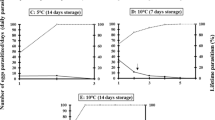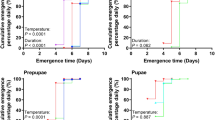Abstract
The eggs of pentatomid species were evaluated to parasitism by Trissolcus basalis (Wollaston) and Telenomus podisi Ashmead after storage in liquid nitrogen. Adults which emerged from stored eggs were kept at 18°C for 120 and 180 days to investigate whether adult dormancy could be associated with host egg storage in liquid nitrogen as a method of mass production of these egg parasitoids. Eggs of Nezara viridula (L.) and Acrosternum pengue (Rolston) were successfully parasitized by T. basalis, as well as Piezodorus guildinii (Westwood) and Dichelops furcatus (F.) by T. podisi. The eggs of Edessa meditabunda (F.) were not parasitized by T. basalis. The emergence of T. podisi from eggs of Euschistus heros (F.) and Podisus nigrispinus (Dallas) stored for 6 months was lower than the control. Females of T. basalis and T. podisi that emerged from stored eggs were kept in dormancy at 18°C. Longevity of T. basalis was influenced by the storage time and sex, but not by the interaction of sex and storage time. For T. podisi, longevity was influenced by the storage time, sex, and by the interaction of sex and storage time. For T. basalis, storage in liquid nitrogen did not affect the fecundity of quiescent females, while the number of parasitized eggs by T. podisi decreased after storage. By the joint use of these techniques, it is possible to optimize mass production of T. basalis so that its life cycle can be monitored and synchronized with the life cycle and availability of hosts.
Similar content being viewed by others
References
Boivin G (1994) Overwintering strategies of egg parasitoids. In: Hassan SA, Wajnberg A (eds) Biological control with egg parasitoids. CAB International, Wallingford, pp 219–244
Corrêa-Ferreira BS (1993) Utilização do parasitóide de ovos Trissolcus basalis (Wollaston) no controle de percevejos da soja. Londrina: EMBRAPA-CNPSo, 40 p (Circular Técnica)
Corrêa-ferreira BS, Moscardi F (1995) Seasonal occurrence and host spectrum of egg parasitoids associated with soybean stink bugs. Biol Control 5:196–202
Corrêa-Ferreira BS, Oliveira MCN (1998) Viability of Nezara viridula (L.) eggs for parasitism by Trissolcus basalis (Woll.), under different storage techniques in liquid nitrogen. Ann Soc Entomol Brasil 27:101–107
Doetzer AK, Foerster LA (2007) Desenvolvimento, longevidade e reprodução de Trissolcus basalis (Wollaston) e Telenomus podisi Ashmead (Hymenoptera: Scelionidae) em condições naturais durante a entressafra da soja no sul do Paraná. Neotropical Entomol 36:233–242
Foerster LA, Doetzer AK (2006) Cold storage of Trissolcus basalis (Wollaston) and Telenomus podisi Ashmead (Hymenoptera: Scelionidae). Biol Control 36:232–237
Foerster LA, Nakama PA (2002) Efeito da estocagem em baixa temperatura na capacidade reprodutiva e longevidade de Trissolcus basalis (Wollaston) e Telenomus podisi Ashmead (Hymenoptera: Scelionidae). Neotropical Entomol 31:115–120
Foerster LA, Doetzer AK, Castro LCF (2004) Emergence, longevity and fecundity of Trissolcus basalis and Telenomus podisi after cold storage in the pupal stage. Pesq Agroplantae Bras Brasília 39:841–845
Golin V, Loiácono MS, Margaría CB, Aquino DA (2011) Natural incidence of egg parasitoids of Edessa meditabunda (F.) (Hemiptera: Pentatomidae) on Crotalaria spectabilis in Campo Novo do Parecis, MT, Brazil. Neotropical Entomol 40:617–618
Kivan M, Kilic N (2005) Effects of storage at low-temperature of various heteropteran host eggs on the egg parasitoid, Trissolcus semistriatus. Biocontrol 50:589–600
Mansingh A (1971) Physiological classification of dormancies in insects. Can Entomol 103:983–1009
Medeiros MA, Schimidt FVG, Loiácono MS, Carvalho VF, Borges M (1997) Parasitismo e predação em ovos de Euschistus heros (Fab.) (Heteroptera: Pentatomidae) no Distrito Federal, Brasil. Ann Soc Entomol Brasil 26:397–401
Nakama PA, Foerster LA (2001) Efeito da alternância de temperaturas no desenvolvimento e emergência de Trissolcus basalis (Wollaston) e Telenomus podisi Ashmead (Hymenoptera: Scelionidae). Neotropical Entomol 30:269–275
Yeargan KV (1979) Parasitism and predation of stink bug eggs in soybean and alfafa fields. Environ Entomol 8:715–719
Acknowledgments
The authors are grateful to Dr. Cesar Augusto Marchioro for critically reviewing the text and the Brazilian National Research Council (CNPq) for the financial support provided.
Author information
Authors and Affiliations
Corresponding author
Additional information
Edited by Madelaine Venzon – EPAMIG
Rights and permissions
About this article
Cite this article
Doetzer, A.K., Foerster, L.A. Storage of Pentatomid Eggs in Liquid Nitrogen and Dormancy of Trissolcus basalis (Wollaston) and Telenomus podisi Ashmead (Hymenoptera: Platygastridae) Adults as a Method of Mass Production. Neotrop Entomol 42, 534–538 (2013). https://doi.org/10.1007/s13744-013-0159-8
Received:
Accepted:
Published:
Issue Date:
DOI: https://doi.org/10.1007/s13744-013-0159-8




